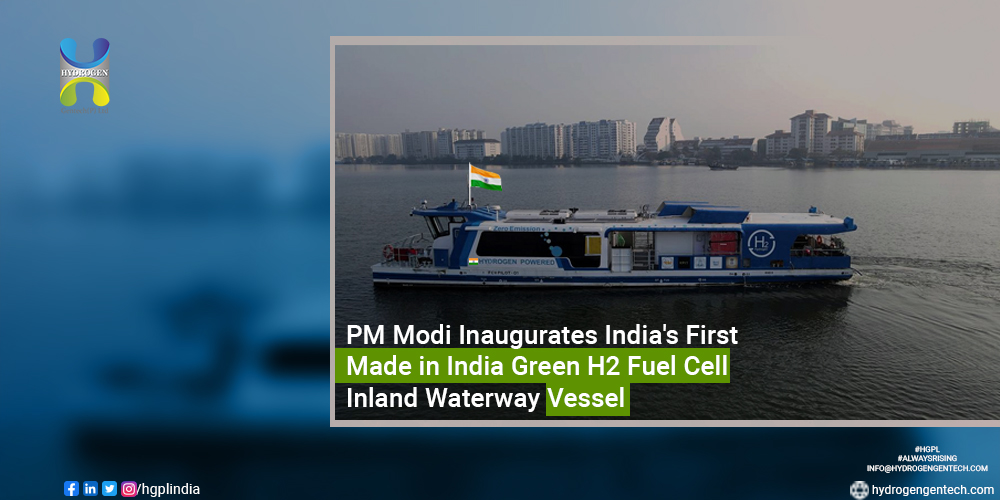
India is making significant strides towards achieving its clean energy goals. In a major development, Prime Minister Narendra Modi recently inaugurated India’s first Made in India green H2 fuel cell inland waterway vessel. This groundbreaking initiative marks a significant milestone in the country’s efforts to promote sustainable and eco-friendly transportation. The vessel is part of the National Green Hydrogen Mission, aimed at developing 5 million metric tons per annum of green hydrogen production capacity by 2030. Let’s delve into the details of this remarkable achievement and its implications for India’s renewable energy sector.
The National Green Hydrogen Mission
The National Green Hydrogen Mission, launched in January 2023, has set an ambitious target to make India a global hub for the production, usage, and export of green hydrogen and its derivatives. With an outlay of Rs 19,744 crores, this mission aims to develop 5 million metric tons per annum of green hydrogen production capacity by 2030. This mission aligns with India’s commitment to reducing carbon emissions and transitioning towards a cleaner and more sustainable energy future.
Inauguration of the Green H2 Fuel Cell Inland Waterway Vessel
During the inauguration ceremony, Prime Minister Narendra Modi unveiled the first indigenous green hydrogen fuel cell inland waterway vessel. This vessel is a testament to India’s commitment to embracing innovative technologies and sustainable transportation solutions. It is a hydrogen-fueled electric vessel, designed to operate on the nation’s inland waterways, reducing carbon emissions and promoting cleaner modes of transportation.
Key Features and Benefits of the Green H2 Fuel Cell Vessel
The green H2 fuel cell inland waterway vessel comes with a range of features and benefits that make it a game-changer in India’s transportation sector. Some of the key features and benefits include:
- Environmentally Friendly
The vessel operates on green hydrogen, a clean and renewable source of energy. Unlike traditional fossil fuel-powered vessels, the green H2 fuel cell vessel produces zero emissions, significantly reducing its environmental footprint and contributing to India’s climate change mitigation efforts.
- Energy-efficient
The fuel cell technology used in the vessel ensures high energy efficiency, making it a cost-effective and sustainable option for transportation on inland waterways. It maximizes the utilization of hydrogen to generate electricity, resulting in lower operational costs and reduced dependency on fossil fuels.
- Reduced Noise Pollution
The use of fuel cells in the vessel contributes to a quieter and more peaceful environment. Unlike conventional diesel-powered vessels, the green H2 fuel cell vessel operates silently, minimizing noise pollution and providing a more pleasant experience for passengers and the surrounding communities.
- Increased Energy Security
By promoting the use of green hydrogen as a fuel source, the green H2 fuel cell vessel helps enhance India’s energy security. It reduces the country’s reliance on imported fossil fuels and strengthens its position as a leader in clean and sustainable energy solutions.
The Significance of the Inauguration
The inauguration of India’s first Made in India green H2 fuel cell inland waterway vessel holds immense significance for several reasons. Firstly, it showcases India’s technological capabilities in the field of renewable energy and reinforces the country’s commitment to reducing carbon emissions and combating climate change.
Secondly, the green H2 fuel cell vessel sets an example for other countries to follow, demonstrating the feasibility and viability of hydrogen-powered transportation. India’s initiative in adopting green hydrogen technology can inspire global efforts towards a more sustainable future.
Furthermore, the inauguration of the vessel signifies India’s progress in achieving its clean energy goals. It highlights the country’s commitment to the development and deployment of innovative and eco-friendly transportation solutions, paving the way for a greener and more sustainable transport sector.
Future Implications and Opportunities
The inauguration of the green H2 fuel cell inland waterway vessel opens up a plethora of opportunities for India’s renewable energy sector. It serves as a catalyst for further research, development, and deployment of hydrogen fuel cell technology across various industries, including transportation, power generation, and manufacturing.
The adoption of green hydrogen has the potential to revolutionize India’s transportation sector, providing a cleaner and more sustainable alternative to fossil fuels. It can contribute to the reduction of greenhouse gas emissions, improve air quality, and create new job opportunities in the renewable energy sector.
Moreover, the successful implementation of the green H2 fuel cell vessel project sets the stage for future collaborations and partnerships between India and other countries in the field of clean energy. It opens up avenues for knowledge exchange, technology transfer, and joint research and development initiatives, fostering global cooperation in addressing the challenges of climate change.
Conclusion
India’s first Made in India green H2 fuel cell inland waterway vessel marks a significant milestone in the country’s journey towards a cleaner and more sustainable future. The inauguration of this vessel reflects India’s commitment to embracing innovative technologies and promoting eco-friendly transportation solutions.
With the National Green Hydrogen Mission at its core, India is making significant strides in developing a robust green hydrogen ecosystem. The use of green hydrogen in transportation can revolutionize the sector, reducing carbon emissions, improving air quality, and enhancing the country’s energy security.
The successful inauguration of the green H2 fuel cell inland waterway vessel sets the stage for further advancements in renewable energy technologies and paves the way for a greener and more sustainable future. As India continues to invest in clean energy initiatives, it is positioning itself as a global leader in the transition towards a low-carbon economy.

